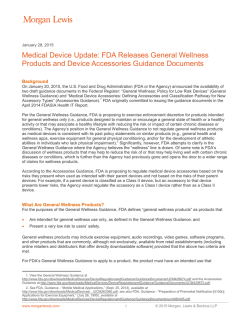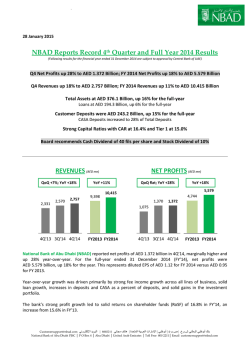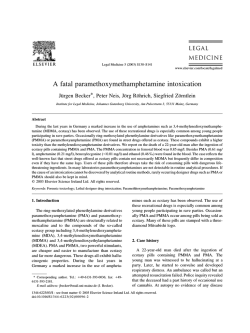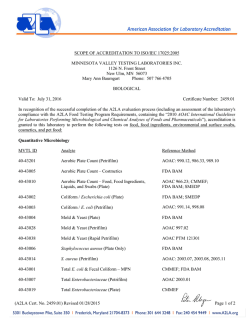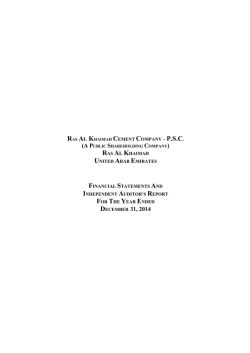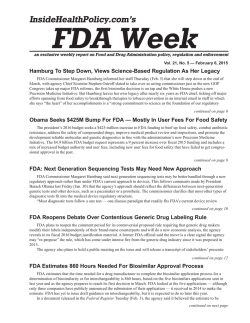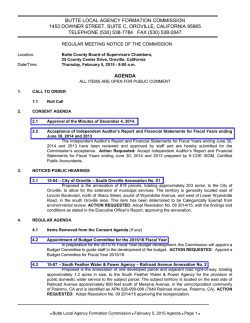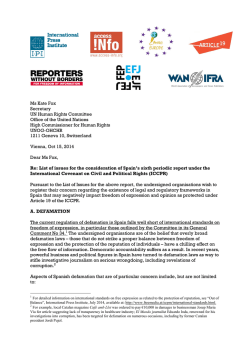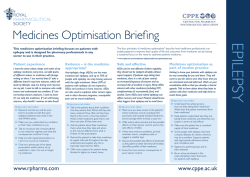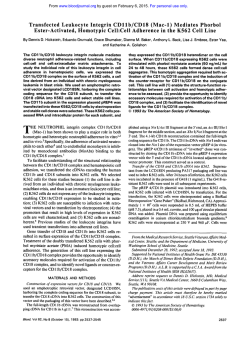
Final rule
Federal Register / Vol. 80, No. 19 / Thursday, January 29, 2015 / Rules and Regulations Dated: January 23, 2015. Kevin J. Wolf, Assistant Secretary for Export Administration. [FR Doc. 2015–01639 Filed 1–28–15; 8:45 am] BILLING CODE 3510–33–P DEPARTMENT OF HEALTH AND HUMAN SERVICES Food and Drug Administration 21 CFR Part 870 [Docket No. FDA–2013–N–0234] Effective Date of Requirement for Premarket Approval for Automated External Defibrillator Systems AGENCY: Food and Drug Administration, HHS. ACTION: Final order. The Food and Drug Administration (FDA or the Agency) is issuing a final order to require the filing of premarket approval applications (PMA) for automated external defibrillator (AED) systems, which consist of an AED and those AED accessories necessary for the AED to detect and interpret an electrocardiogram and deliver an electrical shock (e.g., pad electrodes, batteries, adapters, and hardware keys for pediatric use). DATES: This order is effective on January 29, 2015. FOR FURTHER INFORMATION CONTACT: Linda Ricci, Center for Devices and Radiological Health, 10903 New Hampshire Ave., Bldg. 66, Rm. 1314, Silver Spring, MD 20993, 301–796– 6325, [email protected]. SUPPLEMENTARY INFORMATION: SUMMARY: tkelley on DSK3SPTVN1PROD with RULES I. Background—Regulatory Authorities The Federal Food, Drug, and Cosmetic Act (the FD&C Act), as amended by the Medical Device Amendments of 1976 (the 1976 amendments) (Pub. L. 94– 295), the Safe Medical Devices Act of 1990 (Pub. L. 101–629), the Food and Drug Administration Modernization Act of 1997 (Pub. L. 105–115), the Medical Device User Fee and Modernization Act of 2002 (Pub. L. 107–250), the Medical Devices Technical Corrections Act (Pub. L. 108–214), the Food and Drug Administration Amendments Act of 2007 (Pub. L. 110–85), and the Food and Drug Administration Safety and Innovation Act (FDASIA) (Pub. L. 112– 144), among other amendments, established a comprehensive system for the regulation of medical devices intended for human use. Section 513 of VerDate Sep<11>2014 16:36 Jan 28, 2015 Jkt 235001 the FD&C Act (21 U.S.C. 360c) established three categories (classes) of devices, reflecting the regulatory controls needed to provide reasonable assurance of their safety and effectiveness. The three categories of devices are class I (general controls), class II (special controls), and class III (premarket approval). Under section 513(d) of the FD&C Act (21 U.S.C. 360c(d)), devices that were in commercial distribution before the enactment of the 1976 amendments, May 28, 1976 (generally referred to as ‘‘preamendments devices’’), are classified after FDA has: (1) Received a recommendation from a device classification panel (an FDA advisory committee); (2) published the panel’s recommendation for comment, along with a proposed regulation classifying the device; and (3) published a final regulation classifying the device. FDA has classified most preamendments devices under these procedures. Devices that were not in commercial distribution prior to May 28, 1976 (generally referred to as ‘‘postamendments devices’’) are automatically classified by section 513(f) of the FD&C Act (21 U.S.C. 360c(f)) into class III without any FDA rulemaking process. Those devices remain in class III and require premarket approval unless, and until, the device is reclassified into class I or II or FDA issues an order finding the device to be substantially equivalent, in accordance with section 513(i) of the FD&C Act (21 U.S.C. 360c(i)), to a predicate device that does not require premarket approval. The Agency determines whether new devices are substantially equivalent to predicate devices by means of premarket notification procedures in section 510(k) of the FD&C Act (21 U.S.C. 360(k)) and part 807 (21 CFR part 807). A preamendments device that has been classified into class III and devices found substantially equivalent by means of premarket notification (510(k)) procedures to such a preamendments device or to a device within that type (both the preamendments and substantially equivalent devices are referred to as preamendments class III devices) may be marketed without submission of a premarket approval application (PMA) until FDA issues a final order under section 515(b) of the FD&C Act (21 U.S.C. 360e(b)) requiring premarket approval or until the device is subsequently reclassified into class I or class II. Section 515(b)(1) of the FD&C Act (21 U.S.C. 360e(b)(1)) directs FDA to issue an order requiring premarket approval for a preamendments class III device. PO 00000 Frm 00027 Fmt 4700 Sfmt 4700 4783 Although, under the FD&C Act, the manufacturer of a class III preamendments device may respond to the call for PMAs by filing a PMA or a notice of completion of a product development protocol (PDP), in practice, the option of filing a notice of completion of a PDP has not been used. For simplicity, although corresponding requirements for PDPs remain available to manufacturers in response to a final order under section 515(b) of the FD&C Act (21 U.S.C. 360e(b)), this document will refer only to the requirement for the filing and receiving approval of a PMA. On July 9, 2012, FDASIA was enacted. Section 608(a) of FDASIA (126 Stat. 1056) amended section 513(e) of the FD&C Act (21 U.S.C. 360c(e)), changing the mechanism for reclassifying a device from rulemaking to an administrative order. Section 608(b) of FDASIA amended section 515(b) of the FD&C Act (21 U.S.C. 360e(b)) changing the mechanism for requiring premarket approval for a preamendments class III device from rulemaking to an administrative order. Section 515(b)(1) of the FD&C Act sets forth the process for issuing a final order. Specifically, prior to the issuance of a final order requiring premarket approval for a preamendments class III device, the following must occur: (1) Publication of a proposed order in the Federal Register; (2) a meeting of a device classification panel described in section 513(b) of the FD&C Act; and (3) consideration of comments from all affected stakeholders, including patients, payers, and providers. Section 515(b)(3) of the FD&C Act provides that FDA shall, after the close of the comment period on the proposed order, consideration of any comments received, and a meeting of a device classification panel described in section 513(b) of the FD&C Act, issue a final order to require premarket approval or publish a document terminating the proceeding together with the reasons for such termination. A preamendments class III device may be commercially distributed without a PMA until 90 days after FDA issues a final order (a final rule issued under section 515(b) of the FD&C Act prior to the enactment of FDASIA is considered to be a final order for purposes of section 501(f) of the FD&C Act (21 U.S.C. 351(f))) requiring premarket approval for the device, or 30 months after final classification of the device under section 513 of the FD&C Act, whichever is later. For AED systems, the later of these two time periods is the 90-day period. Therefore, section 501(f)(2)(B) of the FD&C Act (21 U.S.C. 351(f)(2)(B)) requires that a PMA E:\FR\FM\29JAR1.SGM 29JAR1 4784 Federal Register / Vol. 80, No. 19 / Thursday, January 29, 2015 / Rules and Regulations tkelley on DSK3SPTVN1PROD with RULES for such devices be filed within 90 days of the effective date of a final order. However, for the reasons discussed below, FDA does not intend to enforce compliance with the 90-day deadline for PMA submissions for currently marketed AEDs and those AED accessories identified in 21 CFR 870.5310(a) (see further discussion in section V, ‘‘Implementation Strategy’’). Also, a preamendments device subject to the order process under section 515(b) of the FD&C Act (21 U.S.C. 360e) is not required to have an approved investigational device exemption (IDE) (see part 812 (21 CFR part 812)) contemporaneous with its interstate distribution until the date identified by FDA in the final order requiring the filing of a PMA for the device. At that time, an IDE is required only if a PMA has not been filed. If the manufacturer, importer, or other sponsor of the device submits an IDE application and FDA approves it, the device may be distributed for investigational use. If a PMA is not filed by the later of the two dates, and the device is not distributed for investigational use under an IDE, the device is deemed to be adulterated within the meaning of section 501(f)(1)(A) of the FD&C Act (21 U.S.C. 351(f)(1)(A)), and subject to seizure and condemnation under section 304 of the FD&C Act (21 U.S.C. 334) if its distribution continues. Other enforcement actions include, but are not limited to, the following: Shipment of devices in interstate commerce may be subject to injunction under section 302 of the FD&C Act (21 U.S.C. 332), and the individuals responsible for such shipment may be subject to prosecution under section 303 of the FD&C Act (21 U.S.C. 333). FDA requests that manufacturers take action to prevent the further use of devices for which no PMA has been filed. II. Regulatory History of This Device On January 25, 2011, the Circulatory System Devices Panel (‘‘Panel’’) recommended that AED systems be classified as class III devices and subject to premarket approval to provide reasonable assurance of the safety and effectiveness of the device (Ref. 1). The Panel recommended that AED systems be regulated as class III devices because, among other things, they are lifesaving devices. Furthermore, the problems identified in adverse events in the medical device reporting systems and recalls related to AED systems indicated these devices require more regulatory oversight. FDA published a proposed order to require PMAs for AED systems in the Federal Register of March 25, 2013 (78 VerDate Sep<11>2014 16:36 Jan 28, 2015 Jkt 235001 FR 17890). FDA is now requiring PMAs for AED systems, which include AED accessories necessary for the functionality of the AED (e.g., pad electrodes, batteries, adapters, and hardware keys for pediatric use) (‘‘necessary AED accessories’’) (see section IV, ‘‘The Final Order’’). FDA received and has considered comments on the AED systems proposed order as discussed in section III of this document. III. Public Comments in Response to the Proposed Order In response to the March 25, 2013 (78 FR 17890) proposed order to maintain the class III classification and require premarket approval for AED systems, FDA received 66 comments and one petition for reclassification (see FDA– 2013–N–0234–0002).1 The comments and the FDA’s responses to the comments are summarized below. Certain comments are grouped together under a single number because the subject matter of the comments is similar. The number assigned to each comment is purely for organizational purposes and does not signify the comment’s value or importance or the order in which it was submitted. (Comment 1) Many comments indicated that AED systems have already been demonstrated to be safe and effective, and referenced literature and studies supporting the reliability of these devices and the value of AED systems in treating sudden cardiac arrest (SCA). The comments stated that PMAs and associated increased regulatory cost and review time is not warranted and would hinder innovation, increase device cost to consumers, and reduce availability of AED systems. The comments further stated that it is widely recognized that improvement in the survival rate from SCA is due in large part to widespread distribution of AED systems and expressed concern that requiring PMAs would limit availability of the devices. (Response 1) FDA agrees that many currently marketed AEDs have been demonstrated to be effective in clinical use and, when designed and manufactured appropriately, AEDs can be safe and effective. However, FDA believes that there is insufficient information to determine that general and special controls would provide a reasonable assurance of the safety and effectiveness of these devices, which are 1 FDA will respond separately to the reclassification petition and will address the issues raised in that petition in its response. The reclassification petition is available at http:// www.regulations.gov/#!documentDetail;D=FDA2013-N-0234-0002. PO 00000 Frm 00028 Fmt 4700 Sfmt 4700 for a use in supporting or sustaining human life (see section 513(a)(1)(C) of the FD&C Act (21 U.S.C. 360c(a)(1)(C))). Specifically, the postmarket information on AEDs supports increased regulatory review to ensure that device design and manufacturing practices provide a reasonable assurance of safety and effectiveness. FDA acknowledges that the PMA process may result in increased regulatory cost to manufacturers; however, FDA believes that device quality will improve, which will reduce costs associated with postmarket actions including recalls. FDA also agrees that continued efforts to make safe and effective AED systems available is in the interest of public health, but disagrees that this call for PMAs will limit device availability. FDA believes that many manufacturers of currently marketed AEDs already have, or can reasonably obtain, the necessary data to support a PMA, and hence expects AED distribution to continue to meet demand. Also, for the reasons discussed below, FDA does not intend to enforce compliance with the 90-day deadline for submission of PMAs for currently marketed AEDs and necessary AED accessories (for further discussion see section V, ‘‘Implementation Strategy’’). At the January 2011 Panel meeting, the Panel discussed the impact of FDA regulatory scrutiny on innovation. Various Panel members agreed that the appropriate focus should be on assuring reliability of AEDs and that there was no evidence presented to indicate that a call for PMAs would unduly hinder device innovation (Ref. 1). FDA notes that previous significant innovations for AED systems (e.g., new defibrillation waveforms) have been supported by clinical evidence in the 510(k) process and that under the PMA process this clinical evidence is not expected to significantly change. As was mentioned in the proposed order, FDA anticipates that many AED manufacturers already have sufficient clinical evidence to support a PMA. (Comment 2) Several comments noted that AED system failures are often the result of use error or improper maintenance (e.g., expired batteries/ pads, periodic checks not performed, etc.) and not of system failure or malfunction. The comments stated that efforts should be devoted to ensuring appropriate public awareness, training (particularly for lay users), and maintenance to address these issues as opposed to increasing premarket regulatory review. One comment stated that the proposed order should not be finalized until all stakeholders, not only device manufacturers, are engaged in an E:\FR\FM\29JAR1.SGM 29JAR1 tkelley on DSK3SPTVN1PROD with RULES Federal Register / Vol. 80, No. 19 / Thursday, January 29, 2015 / Rules and Regulations integrated approach to increase the likelihood that AED systems will be available and functional when needed. (Response 2) FDA agrees that AED system training and maintenance are important to help ensure AED system availability and proper use and also believes manufacturers and users are in the best position to develop and implement training and maintenance materials. FDA supports ongoing discussions and efforts to improve training and maintenance, but disagrees that these activities should delay finalizing the requirement for PMAs for these devices. Although we recognize that there have been some medical device reports (MDRs) associated with use errors, the focus of FDA’s review of MDRs and recalls of AED systems has been related to problems with the quality of these devices as related to device design and manufacture and FDA continues to believe that requiring PMAs is appropriate. (Comment 3) Several comments stated that special controls, including performance testing to industry standards, device labeling, guidance documents, human factors analysis and design, summary of field actions and mitigations to address Quality System (QS) concerns, risk management, and post-market surveillance were sufficient to regulate AED systems as class II devices under the existing 510(k) regulatory regime. One comment indicated that several of the regulatory controls identified by FDA as consistent with PMA requirements—such as premarket inspections, review of changes that could significantly affect the safety or effectiveness of the device, and postmarket surveillance—could also be conducted under the 510(k) regime. Other comments supported FDA’s proposal to maintain the devices in class III and agreed that the manufacturing controls, premarket review requirements, and assessment of lay use are best managed under the PMA process. (Response 3) FDA disagrees that there is sufficient information to determine that general and special controls would provide a reasonable assurance of safety and effectiveness of these devices given safety concerns related to the manufacturing processes and design changes, problems which FDA considered in determining that PMAs are warranted (see section 513(a)(1)(C) of the FD&C Act (21 U.S.C. 360c(a)(1)(C))). FDA does not generally conduct preclearance inspections under the 510(k) process because such information is not required in a 510(k) submission under the FD&C Act or FDA regulations. Further, under section VerDate Sep<11>2014 16:36 Jan 28, 2015 Jkt 235001 513(f)(5) of the FD&C Act (21 U.S.C. 360c(f)(5)), FDA may not withhold a 510(k) ‘‘because of a failure to comply with any provision of this Act unrelated to a substantial equivalence decision, including a finding that the facility in which the device is manufactured is not in compliance with good manufacturing requirements as set forth in regulations of the Secretary under section 520(f) (other than a finding that there is a substantial likelihood that the failure to comply with such regulations will potentially present a serious risk to human health).’’ In contrast, under section 515(c)(1)(C) of the FD&C Act (21 U.S.C. 360e(c)(1)(C)), a PMA must include ‘‘a full description of the methods used in, and the facilities and controls used for, the manufacturing, processing, and when relevant, packing and installation of, such device.’’ Moreover, many of the design and manufacturing changes that have led to AED system recalls were not required to be reported to FDA under the 510(k) process. If these changes had been reported prior to implementation, as would be required in the PMA regime, these recalls may have been avoided. FDA continues to believe that the necessary regulatory controls for AED systems are consistent with the PMA review process, and that the 510(k) process does not provide sufficient regulatory oversight for these devices. Similarly, FDA’s oversight of postmarket changes to devices is very different in the 510(k) context as compared to the PMA context. Under 21 CFR 807.81, FDA requires 510(k)s for a change to a device only when the change ‘‘could significantly affect the safety or effectiveness of the device, e.g., a significant change or modification in design, material, chemical composition, energy source, or manufacturing process. ’’ In contrast, under 21 CFR 814.39, FDA requires PMA supplements (including 30-day notices) for any change to a PMA-approved device that affects safety or effectiveness. These differences in authorities, among the other reasons discussed above, warrant regulation of AEDs in class III. (Comment 4) A few comments indicated that existing AED and AED accessory manufacturers are already subject to the QS regulation (21 CFR 820) and manufacturing quality would not be measurably improved as a result of requiring PMAs. One comment noted that specific expectations under the QS regulation for design controls, purchasing controls, and other issues identified by FDA as problematic for AEDs could be addressed by special controls and other regulations, and AEDs could remain in class II. One PO 00000 Frm 00029 Fmt 4700 Sfmt 4700 4785 comment further stated that such concerns could be managed via postmarket controls, which are available under the 510(k) regime, such as submission of a summary of recent field actions and related design mitigations. (Response 4) FDA disagrees with the comments. FDA acknowledges that AED and AED accessory manufacturers are already subject to the QS regulation and that QS requirements result in rigorously designed and manufactured devices and resultant quality improvements. By requiring premarket review of QS processes as well as device changes for AEDs, FDA believes the PMA process will provide a reasonable assurance of safety and effectiveness (see Response 3 above). (Comment 5) One comment stated that certain AED accessories, specifically electrodes, cables, and adapters, are well-understood devices and that their classification into class III is not warranted. The comment stated that these accessories could be adequately regulated in class II with special controls, as is already the case when these accessories are used with manual defibrillators. The comment recommended special controls, including the following: Performance testing, usability evaluation, labeling, biocompatibility, and readiness for use. Two comments stated that because AED accessories often have identical designs and the same intended use as accessories used with class II manual defibrillators, FDA should not perform duplicative reviews under both the 510(k) and PMA regimes and that PMA review should be required only when use of the accessory with an AED results in a change in intended use or design. (Response 5) Accessories necessary for an AED to detect and interpret an electrocardiogram and deliver an electrical shock (e.g., battery, pad electrode, adapter, and hardware keys for pediatric use) are necessary for AED system functionality. Failure of these necessary accessories leads to the same negative outcomes as a failure of the AED itself; e.g., an AED not ready for use because of a faulty battery is unable to detect heart rhythm abnormalities and/or deliver a defibrillation shock to a victim of SCA. FDA’s review of adverse events and recalls has shown that problems with AED accessories have occurred during clinical use. As such, FDA continues to believe that the same regulatory oversight is warranted for certain critical accessories (i.e., batteries, pad electrodes, adapters, and hardware keys for pediatric use) as for the AEDs with which they are used. As discussed in the response to Comment 3 above, FDA does not believe that E:\FR\FM\29JAR1.SGM 29JAR1 tkelley on DSK3SPTVN1PROD with RULES 4786 Federal Register / Vol. 80, No. 19 / Thursday, January 29, 2015 / Rules and Regulations adequate regulatory controls are available under the 510(k) process, and hence PMAs are necessary to provide a reasonable assurance of safety and effectiveness. (Comment 6) Several comments questioned the validity of FDA’s data regarding adverse events associated with AED failures. One comment noted that FDA provided no data in the proposed order on the frequency of adverse events or relationship of number of events to total distribution and use of AEDs. The comment requested additional information from FDA to support the validity of the MDR analysis presented at the 2011 Panel and relied upon to support the proposed order. A few comments presented alternate analyses of MDR data that suggested that MDRs for AEDs are not increasing. One comment presented an analysis that showed no statistically significant increase in the rate of adverse event reports over the time period of 2007 to 2011. Two comments stated that a majority of AED MDRs reported to FDA resulted from self-test errors—which are reported as malfunction MDRs because they could cause or contribute to a death or serious injury but do not represent device failures in clinical use. The comments contended that any analysis of MDRs should focus instead on actual use adverse events, which would represent a small subset of the overall MDRs. One comment stated that self-test related events are representative of an effective design risk mitigation strategy being employed for AEDs and that because AEDs are often in standby for a large percentage of time, self-test detection of problems before use should not be included in the overall assessment of the benefit-risk profile for AEDs. Two comments requested further guidance from FDA on MDR reporting expectations for AEDs. (Response 6) Although FDA requires manufacturers to submit an MDR when their device may have caused or contributed to a death, serious injury, or in certain situations when their device has malfunctioned, FDA acknowledges that there are limitations on the review of MDR data, including the fact that FDA typically does not have complete information on the number of devices in distribution from which to calculate adverse events rates. These limitations were discussed at the 2011 Panel meeting. FDA has previously stated that fatality statistics and injury statistics from MDRs should be considered in light of underreporting (58 FR 61952 at 61972, November 23, 1993). In addition, FDA notes that the evaluation of MDR data for AEDs was focused on VerDate Sep<11>2014 16:36 Jan 28, 2015 Jkt 235001 manufacturing and design concerns and was not aimed at developing specific failure rates. Moreover, FDA believes that the large number of devices in distribution and the life-saving nature of these devices combined with the steady rate of MDRs support a call for PMAs to help ensure that these devices are adequately designed and manufactured so that they are available when needed. FDA disagrees that evaluation of adverse events should focus only on those events that occur during clinical use. Although some distributed AEDs may seldom be used, this does not reduce the importance that they are safe and effective when needed. FDA acknowledges the importance of AED self-test features and recognizes that many self-test failures are not indicative of issues with overall device quality. FDA believes, however, that some selftest failures signal significant quality problems arising from device design or manufacturing issues and are appropriately considered as adverse events if recurrence of such failures could, for example, render the device unavailable for use when needed. FDA also recognizes that some MDRs may eventually be found to be the result of problems not associated with the device; however, this concern is applicable to all devices subject to adverse event reporting requirements and FDA does not believe such reports unduly influence overall reporting numbers. FDA also notes that our review of available information, as presented at the January 2011 Panel meeting, included data on voluntary corrections and removals (i.e., ‘‘recalls’’) of AEDs pursuant to section 519(g) of the FD&C Act (21 U.S.C. 360i(g)). Recalls are conducted ‘‘(A) to reduce a risk to health posed by the device, or (B) to remedy a violation of this Act caused by the device which may present a risk to health,’’ and as such may reflect safety concerns for AEDs (section 519(g)(1) of FD&C Act (21 U.S.C. 360i(g)(1)). Since the January 2011 Panel meeting, over 40 additional class I or class II recalls have been conducted by AED manufacturers and have impacted over 2 million distributed AEDs (Ref. 2). The root cause of these recalls has been attributed to a variety of causes, with design controls, purchasing controls, and receiving acceptance activities being the most common. FDA continues to believe that the recall data reinforces the overall conclusion regarding the inadequacy of regulatory controls for AED systems under the 510(k) process. Additional guidance on MDR requirements for AEDs is beyond the scope of this document; however, FDA PO 00000 Frm 00030 Fmt 4700 Sfmt 4700 intends to continue efforts to clarify medical device reporting expectations and manufacturers who have questions regarding their reporting obligations should contact FDA. (Comment 7) Several comments responded to FDA’s request for feedback regarding whether 15 months is sufficient to allow companies to collect information necessary to support submission of a PMA. Two comments stated that this issue was dependent on the data expected by FDA and that FDA should provide more guidance in this respect. One comment requested clarification on what clinical data is known to FDA that would support a PMA because it is critical that AED manufacturers understand the type and amount of data that will be required. One comment stated that it is unclear what FDA’s expectations would be for clinical trials of new AEDs or the need for clinical trials for AED accessories given available less burdensome methods for obtaining performance data on accessories. Another comment requested clarification on whether AED manufacturers would be expected to retest and re-validate older AED models to currently recognized standards. One comment requested clarification on when marketing materials for AEDs would need to comply with 21 CFR 801.109. One comment suggested that the 15month period should be extended to 30 months, which the commenter claimed would be consistent with section 501(f)(2)(B) of the FD&C Act (21 U.S.C. 351(f)(2)(B). One commenter requested clarification regarding whether the 15 months started at the 90th day after a final order was issued and another comment indicated that 15 months should be sufficient, but that the 15 months should not include FDA’s 180day PMA review time. One comment suggested that FDA require PMAs 90 days after the final order. (Response 7) The data required to support premarket approval will vary by device and the specific data requirements. FDA is aware of clinical study information that can be leveraged for AEDs from both published studies and clinical data previously submitted to FDA under the 510(k) process, and, as was stated in the proposed order, FDA believes that many AED accessories ‘‘may need to submit nonclinical performance testing with confirmatory animal studies in order to support independent PMA approval’’ (78 FR 17894, March 25, 2013). Performance testing of AEDs must be provided in a PMA to support a reasonable assurance of safety and effectiveness. Although retesting older E:\FR\FM\29JAR1.SGM 29JAR1 tkelley on DSK3SPTVN1PROD with RULES Federal Register / Vol. 80, No. 19 / Thursday, January 29, 2015 / Rules and Regulations AED models to currently recognized standards is one way to meet the performance testing requirements, compliance with such standards is voluntary and manufacturers may submit a justification for how other testing conducted on their devices provides equivalent assurances of safety and effectiveness. FDA encourages manufacturers to proactively engage FDA via the pre-submission process to discuss the specific data needed for their PMAs (Ref. 3). FDA notes that existing prescription AEDs are already subject to 21 CFR 801.109, and will remain so after this call for PMAs. FDA review of AED PMAs will include review of the associated AED labeling to ensure such device labeling complies with regulatory requirements. FDA notes that the 30 months discussed in section 501(f)(2)(B) of the FD&C Act (21 U.S.C. 351(f)(2)(B)) references the date from initial classification of a device into class III. AEDs have been classified as class III for more than 30 months, and hence this statutory provision has expired. FDA also acknowledges that it is in the interest of public health to ensure the availability of AEDs because they are life-saving devices and their clinical use is well-established. After consideration of the comments, FDA continues to believe that the proposed 15 months for filing a PMA (Ref. 4) strikes an appropriate balance between the need to ensure continued availability of AEDs for the public health reasons stated above and the implementation of PMA requirements to ensure the safety and effectiveness of AEDs. For currently marketed AEDs, FDA does not intend to enforce compliance with the 90-day deadline by which PMAs must be submitted for 15 months after that deadline (i.e., 18 months after the effective date of the final order), as long as a notice of intent to file a PMA is submitted within 90 days of the effective date of the final order (see section V, ‘‘Implementation Strategy’’). Even if a notice of intent and PMA are submitted by these dates, manufacturers must cease distribution of devices upon receiving a not approvable or denial decision rendered on a PMA. To resume distribution, these manufacturers must receive PMA approval for their devices. Moreover, for currently marketed necessary AED accessories, FDA does not intend to enforce compliance with the 90-day deadline by which PMAs must be submitted for 57 months after that deadline (i.e., 5 years after the effective date of the final order) (see section V, ‘‘Implementation Strategy’’). Continued availability of necessary AED accessories, including consumable VerDate Sep<11>2014 16:36 Jan 28, 2015 Jkt 235001 accessory items (e.g., pad electrodes) and accessories with limited useful life (e.g., batteries), is critical to ensuring the safety and efficacy of currently marketed AEDs during the time while PMAs for those AEDs are being pursued. In addition, the continued availability of necessary accessories for ‘‘legacy devices’’—individual AEDs that have been distributed and are currently in use (e.g., in public facilities, etc.) and for which the manufacturer is not seeking PMA approval for that AED model—ensures the availability of functional legacy AEDs until they are replaced with PMA-approved AEDs. (Comment 8) One commenter stated that FDA did not have a legal basis for continuing with finalization of a call for PMAs for AED systems because FDA failed to convene a panel as is required under FDASIA prior to issuing a final order. The commenter stated that FDA may not rely on the 2011 pre-FDASIA Panel because that Panel meeting was related to reclassifications under section 515(i) of the FD&C Act (21 U.S.C. 360e(i)) and not related to calls for PMAs under section 515(b) of the FD&C Act (21 U.S.C. 360e(b)). The commenter further contended that the 2011 Panel neither considered new information contained in a reclassification petition submitted to FDA in 2009 nor adequately discussed the appropriateness of class II special controls. (Response 8) FDA disagrees with the comment that FDA does not have a legal basis to finalize an order calling for PMAs for AED systems. Pursuant to FDASIA, the amendments to section 515(b) of the FD&C Act require, in relevant part, that issuance of an administrative order calling for PMAs for a preamendments device be preceded by a proposed order and a meeting of a classification panel. As amended, this section of the FD&C Act does not prescribe when these two events (the panel and proposed order) must occur in relation to each other. More importantly, FDA believes that the Panel’s deliberations and recommendations remain relevant and fully satisfy the requirements in section 515(b) of FD&C Act. FDA disagrees with the comment that the Panel did not consider new information contained in the 2009 reclassification petition. A representative from the petitioner was present at the meeting and provided comments on the reclassification petition during the Panel meeting (Ref. 1). In addition, the petitioner was given an opportunity to explain the petitioner’s reasons for why AEDs should be class II devices, including a PO 00000 Frm 00031 Fmt 4700 Sfmt 4700 4787 discussion of the special controls described in the reclassification petition. Therefore, the Panel heard the petitioner’s arguments and these arguments were available for the Panel’s consideration when it made its recommendation. (Comment 9) One commenter objected to FDA’s use of the term ‘‘diagnose’’ in the proposed order to describe the functionality of AEDs (78 FR 17893, March 25, 2013), and stated that AEDs sense shockable rhythms and are not diagnostic devices. (Response 9) FDA disagrees that these devices do not perform diagnostic functions. AEDs analyze and interpret ECG data to produce an assessment as to whether a shock should be delivered; while FDA does believe that AEDs have diagnostic functions, we note that the regulatory identification for the device in 21 CFR 870.5310(a), as finalized in the order, does not use the term diagnose, and instead describes the function of the device as ‘‘analyzes’’ and ‘‘interprets.’’ (Comment 10) One commenter stated that FDA’s proposal to allow manufacturers to ‘‘bundle’’ several AED models under a single PMA is inconsistent with the PMA regulatory paradigm, which relies on a device-bydevice assessment. The comment points to FDA’s guidance on bundling, which states that ‘‘[g]enerally, [manufacturers] should not bundle differing generic device types in a single PMA submission because of the substantially different pre-clinical and clinical data needed to support each of the devices’’ (Ref. 5). (Response 10) FDA disagrees with the comment. Different AED models can be included in one PMA if they are the same generic device type. Because shock advisory algorithms and defibrillation waveforms will likely be common across various models from a given manufacturer of devices, FDA expects the clinical data needed to support devices within an appropriately bundled AED PMA to be the same. However, because of the differences in device labeling and user requirements between professional and lay use devices, FDA continues to believe that separate PMAs should be submitted for a manufacturer’s professional use versus lay use devices. FDA believes this approach is least burdensome to manufacturers and is consistent with the bundling guidance, which states that ‘‘[b]undling is appropriate for devices that present scientific and regulatory issues that can most efficiently be addressed during one review’’ (Ref. 5). (Comment 11) One comment requested clarification on whether E:\FR\FM\29JAR1.SGM 29JAR1 tkelley on DSK3SPTVN1PROD with RULES 4788 Federal Register / Vol. 80, No. 19 / Thursday, January 29, 2015 / Rules and Regulations separate PMAs are required for AEDs and the associated AED accessories when a company manufacturers both for use together. Two comments requested additional clarification on whether accessories not specified in the proposed order (such as electrocardiograph modules and electrodes, training pads/batteries, protective carrying cases, Bluetooth modules, hardware keys or specialized pads to reduce energy for pediatric use, self-testers, SpO2/blood pressure monitoring devices, cardiopulmonary resuscitation (CPR) aids, medical device data systems (MDDS), etc.) would require PMAs. One comment suggested that AED accessories that are already 510(k) cleared should not be subject to premarket approval by virtue of being used with an AED. (Response 11) In response to this comment, FDA has revised the identification language to clarify that AED accessories regulated under 21 CFR 870.5310 are ‘‘those accessories necessary for the AED to detect and interpret an electrocardiogram and deliver an electrical shock (e.g., battery, pad electrode, adapter, and hardware keys for pediatric use).’’ Manufacturers of accessory devices that are not addressed by the final order and are not already the subject of an existing classification regulation should contact FDA. Under the final order, manufacturers must submit PMAs for accessories that are necessary for operation of the AED system (e.g., accessories necessary to allow the AED to detect or interpret an electrocardiogram or deliver a defibrillation shock). These AED accessories include batteries, pad electrodes (including reduced energy pads for pediatric use), adapters, and hardware keys for pediatric use. In response to this comment, FDA has added ‘‘hardware keys for pediatric use’’ to the identification. Necessary AED accessories that are for use with a specific AED should be included in that PMA for the AED system as a whole. Alternatively, necessary AED accessories, including those manufactured by a third party, may be submitted in their own PMAs. Accessories that are not necessary for the functionality of the AED are not addressed by the final order. Currently marketed AED accessories that are not addressed by the final order, such as SpO2/blood pressure monitoring devices, ECG modules and testers, CPR aids, and MDDS, may be subject to other regulations and will continue to be subject to those existing regulations. Training accessories such as training pads and batteries for training-only VerDate Sep<11>2014 16:36 Jan 28, 2015 Jkt 235001 AEDs are not currently subject to any additional regulations, and will not become so as a result of the final order. (Comment 12) One comment requested clarification regarding AEDs being considered adulterated 90 days after the effective date of a final order in the absence of submission of a statement of intent to submit a PMA or the submission of a full PMA. The comment questioned whether devices legally distributed prior to the 90th day could remain in distribution. Another comment requested clarification on whether manufacturers could continue to provide consumable accessory items (such as batteries and pads) for previously distributed devices even if a PMA will not be submitted for that AED model. Two comments requested clarification on how and whether manufacturers would be allowed to distribute components required for field servicing of a device, including refurbished replacement devices, before PMAs are submitted for the devices. (Response 12) Under the final order (see section IV, ‘‘the Final Order’’) and section 501(f)(2)(B) of the FD&C Act, PMAs must be submitted within 90 days after the effective date of the final order for currently marketed AED systems. If a PMA is not submitted, the devices are adulterated. However, for the reasons discussed above, for currently marketed AEDs, FDA does not intend to enforce compliance with the 90-day deadline by which PMAs must be submitted for 15 months after that deadline (i.e., 18 months after the effective date of the final order), as long as a notice of intent to file a PMA is submitted within 90 days of the effective date of the final order (see section V, ‘‘Implementation Strategy’’). For currently marketed necessary AED accessories, FDA also does not intend to enforce compliance with the 90-day deadline by which PMAs must be submitted for 57 months after that deadline (i.e., 5 years after the effective date of the final order) (see section V, ‘‘Implementation Strategy). This intention applies to necessary AED accessories regardless of whether a PMA is being or has been sought for the AED model. (Comment 13) One comment indicated that premarket review of medical devices such as AEDs should include review of the software embedded into the devices, including review of software verification and validation documentation. The comment noted that such review should also occur for software modifications and software developed for maintenance of the devices, including self-test functions. The comment relayed the importance of having reviewers with PO 00000 Frm 00032 Fmt 4700 Sfmt 4700 adequate training, expertise, and experience. (Response 13) FDA agrees with the comment. Review of AEDs under the 510(k) process has included a detailed review of software documentation supporting premarket submissions by appropriately trained and experienced FDA reviewers. The PMA review will also involve a review of software documentation and will be conducted by trained and experienced FDA reviewers. (Comment 14) One comment suggested an alternative regulatory approach whereby AEDs for medical professional use be reclassified into class II and public access defibrillators used by laypersons remain in class III with PMAs required. The comment stated that professional use devices have advanced functionality and are operated by skilled and trained professionals, which lessens the chance of human factor errors and increases the likelihood that the user will be able to recognize and troubleshoot any malfunctions. The comment stated that such users can rely on past experience and other means of attempting to rescue a patient, whereas lay users are often fully reliant on the AED. Two comments also indicated that professional use devices are typically manual defibrillators with additional functionality, including AED, and that the proposed order would create an inconsistent system whereby the same hardware if used only for manual defibrillation would be class II, but by virtue of configuring the device to include AED functionality would become a PMA class III product. (Response 14) FDA disagrees with the comments and believes that the submission of PMAs is warranted regardless of the intended user of the device. FDA does not believe that there is sufficient information to establish special controls to provide a reasonable assurance of safety and effectiveness of the device regardless of the training of AED users. FDA recognizes that some manual defibrillators and AEDs share common hardware and software platforms, and hence devices with similar or identical platforms may receive different regulatory review based on the configuration. For the reasons previously stated, however, FDA continues to believe AED systems should be class III devices. FDA also notes that the performance and other data needed to support safety and effectiveness for hardware and software platforms for both types of devices would be nearly identical; the difference would be related to the amount of E:\FR\FM\29JAR1.SGM 29JAR1 tkelley on DSK3SPTVN1PROD with RULES Federal Register / Vol. 80, No. 19 / Thursday, January 29, 2015 / Rules and Regulations information that must be submitted to FDA. For a PMA, more information on the design controls process is required to be submitted whereas for a 510(k) submission, some information may not need to be submitted and instead can reside within the company’s overall quality system and associated design documentation. Such situations of different regulatory processes have occurred in other product areas including contact lenses (daily-wear are typically class II, whereas extended wear are class III) and ablation devices (general surgical use are class II, whereas use for treatment of atrial fibrillation is class III), and FDA does not believe this changes the overall rationale supporting the need for PMAs. (Comment 15) Two comments noted that there are numerous companies that refurbish and/or resell AEDs. The comments requested that FDA include AED resellers and refurbishers in their consideration of regulatory strategy. (Response 15) Regardless of the supplier, the introduction or delivery for introduction into interstate commerce of any device that is adulterated is a prohibited act under section 301 of the FD&C Act (21 U.S.C. 331) (see Comment 12). FDA encourages refurbishers and resellers who have questions about the continued distribution of AEDs to contact FDA via the pre-submission process. (Comment 16) One comment requested clarification of the process for modifications of currently marketed AEDs (and notifying FDA of such modifications) during the 90-day period after the final order is issued. One comment stated that given the nature of commercial, electrical and mechanical components used in AEDs, an extended transition period without the ability to implement changes would not be tenable and would result in unavailability of devices. One comment requested clarification on 510(k) submissions accepted for review, but for which no decision had been rendered, prior to the effective date of a final order calling for PMAs. (Response 16) Under 21 CFR 870.5310, as amended, all new AED and necessary AED accessories must have an approved PMA in effect before being placed in commercial distribution. We recommend that manufacturers of currently marketed AEDs contact FDA regarding implementation of any changes necessary for their AEDs in order to address safety concerns or to support ongoing distribution while PMA approval is being sought. FDA understands that issues may arise relating to part obsolescence or changes necessary to reduce a risk to health VerDate Sep<11>2014 16:36 Jan 28, 2015 Jkt 235001 posed by a currently marketed AED that is not functioning properly. All other changes need to be accounted for in a PMA. Moreover, all new AED and necessary AED accessories must have an approved PMA in effect before being placed in commercial distribution. (Comment 17) One comment objected to the comparisons made by FDA at the 2011 Panel meeting between implanted cardioverter defibrillators (ICDs) (PMA devices) and AEDs. The comment noted the number of commercial components (e.g., components supplied to multiple industries for a variety of uses) in order to maintain affordable price-points for AEDs and the potentially burdensome PMA supplements that would be necessary to support incremental changes in manufacturing for AEDs. The comment further contended that purchased component-related recalls for AEDs have largely been a result of latent component failures and that FDA’s examples at the 2011 Panel meeting of QS concerns related to changes to purchased components or device design would not have been averted by the stricter premarket regulatory oversight via PMA supplements. (Response 17) FDA acknowledges that more stringent regulatory oversight via the PMA process may not completely eliminate AED recalls. FDA also recognizes that AEDs typically contain commercial components and manufacturers will need to submit PMA supplements for changes to these components, as well as changes to suppliers and manufacturing processes. Use of commercial components in PMA devices is not uncommon and changes at the component level may have led to some AED recalls and adverse events, providing further support for increased regulatory review. FDA continues to believe that these failures and the need for careful consideration and adequate verification and validation of such changes support more rigorous review under the PMA process. (Comment 18) One comment requested clarification on activities during the time after a notice of intent to file is submitted, including whether FDA will place additional postmarket approval requirements on previously distributed products as allowed under 21 CFR 814.82. The comment further asked whether IDEs would be required for design changes (e.g., would an IDE be required to conduct human factors/ usability studies). (Response 18) FDA will consider the need for postapproval requirements in the context of each manufacturer’s PMA submission and the devices in distribution. FDA does not intend to PO 00000 Frm 00033 Fmt 4700 Sfmt 4700 4789 exempt manufacturers from the IDE requirements and hence any study which meets the IDE requirements must be conducted in accordance with the requirements of 21 CFR parts 50 and 812. There will be no extended period for filing an IDE and studies may not be initiated without appropriate IDE approvals. Manufacturers who have questions regarding whether an IDE is needed for a particular AED study are encouraged to interact with FDA via the pre-submission process. IV. The Final Order FDA is adopting its findings as published in the preamble of the proposed order (78 FR 17890, March 25, 2013) and issuing this final order to require the filing of a PMA for AED systems under 515(b) of the FD&C Act (21 U.S.C. 360e(b)). An AED system consists of an AED and those accessories necessary for the AED to detect and interpret an electrocardiogram and deliver an electrical shock (e.g., battery, pad electrode, adapter, and hardware keys for pediatric use). An AED system analyzes the patient’s electrocardiogram, interprets the cardiac rhythm, and automatically delivers an electrical shock (fully automated AED), or advises the user to deliver the shock (semi-automated or shock advisory AED) to treat ventricular fibrillation or pulseless ventricular tachycardia. Under section 515(b)(1)(A) of the FD&C Act (21 U.S.C. 360e(b)(1)(A)), PMAs for AED systems are required to be filed on or before 90 days after the effective date of a final order. This final order will revise 21 CFR part 870. V. Implementation Strategy Based on comments on the proposed order, we are clarifying FDA’s intentions regarding enforcing compliance with the final order (see section IV, ‘‘The Final Order’’) and section 501(f)(2)(B) of the FD&C Act (21 U.S.C. 351(f)(2)(B)). A. Currently Marketed AEDs Under the final order and section 501(f)(2)(B) (21 U.S.C. 351(f)(2)(B)), PMAs for currently marketed AEDs are required to be filed on or before 90 days after the effective date of a final order. However, for currently marketed AEDs, FDA does not intend to enforce compliance with this 90-day deadline for 15 months after that deadline (i.e., 18 months after the effective date of the final order), as long as notice of intent to file a PMA is submitted within 90 days of the effective date of the final order. The notification of the intent to file a PMA submission must include a E:\FR\FM\29JAR1.SGM 29JAR1 4790 Federal Register / Vol. 80, No. 19 / Thursday, January 29, 2015 / Rules and Regulations list of all model numbers for which a manufacturer plans to seek marketing approval through a PMA. In conducting any clinical studies, AEDs may be distributed for investigational use if the requirements of the IDE regulations (21 CFR part 812) are met. There will be no extended period for filing an IDE nor exemption from IDE requirements, and studies may not be initiated without appropriate IDE approvals, where necessary. B. Currently Marketed Necessary AED Accessories Under the final order and section 501(f)(2)(B) (21 U.S.C. 351(f)(2)(B)), PMAs for currently marketed necessary AED accessories are required to be filed on or before 90 days after the effective date of this final order. However, for currently marketed necessary AED accessories, FDA does not intend to enforce compliance with this 90-day deadline for 57 months after the deadline (i.e., 5 years after the effective date of the final order). Currently marketed necessary AED accessory manufacturers are not required to file an intent-to-file by the 90-day deadline. After the effective date of the final order, new AEDs and necessary AED accessories must have approved PMAs to be legally marketed. The following tables show the regulatory timetable for currently marketed AEDs and necessary AED accessories. TABLE 1—CURRENTLY MARKETED AEDS Timetable for which FDA does not intend to enforce compliance (time after effective date of order) Distribution period (time after effective date of order) Intent to File a PMA ...... 90 days ............................................................ File a PMA .................... 18 months ........................................................ Devices included in an intent to file: 18 months. Devices not included in intent to file: 90 days. Until a not approvable decision or denial decision is issued; can continue distribution if an approval order is issued. TABLE 2—CURRENTLY MARKETED NECESSARY AED ACCESSORIES Intent to File a PMA ...... File a PMA .................... Timetable for which FDA does not intend to enforce compliance (time after effective date of order) Distribution period (time after effective date of order) N/A ................................................................... 60 months ........................................................ N/A. Until a not approvable decision or denial decision is issued; can continue distribution if an approval order is issued. VI. Environmental Impact The Agency has determined under 21 CFR 25.30 (h) that this action is of a type that does not individually or cumulatively have a significant effect on the human environment. Therefore, neither an environmental assessment nor an environmental impact statement is required. tkelley on DSK3SPTVN1PROD with RULES VII. Paperwork Reduction Act of 1995 The final order refers to previously approved collections of information found in FDA regulations. These collections of information are subject to review by the Office of Management and Budget (OMB) under the Paperwork Reduction Act of 1995 (44 U.S.C. 3501– 3520). The collections of information in 21 CFR part 812 have been approved under OMB control number 0910–0078; the collections of information in 21 CFR part 807, subpart E, have been approved under OMB control number 0910–0120; the collections of information in 21 CFR part 814, subpart B, have been approved under OMB control number 0910–0231; and the collections of information under 21 CFR part 801 have been approved under OMB control number 0910–0485. VIII. Codification of Orders Prior to the amendments by FDASIA, section 515(b) of the FD&C Act (21 VerDate Sep<11>2014 16:36 Jan 28, 2015 Jkt 235001 U.S.C. 360e(b)) provided for FDA to issue regulations to require PMA approval for preamendments devices or devices found substantially equivalent to preamendments devices. Section 515(b) of the FD&C Act (21 U.S.C. 360e(b)), as amended by FDASIA, provides for FDA to require PMA approval for such devices by issuing a final order, following the issuance of a proposed order in the Federal Register. FDA will continue to codify the requirement for a PMA approval in the Code of Federal Regulations. Therefore, under section 515(b)(1)(A) of the FD&C Act (21 U.S.C. 360e(b)(1)(A)), as amended by FDASIA, in this final order, we are requiring PMA approval for AED systems and we are making the language in 21 CFR 870.5310 consistent with the final version of this order. IX. References The following references have been placed on display in the Division of Dockets Management (see ADDRESSES) and may be seen by interested persons between 9 a.m. and 4 p.m., Monday through Friday. (FDA has verified the Web site address, but FDA is not responsible for any subsequent changes to the Web site after this document publishes in the Federal Register.) PO 00000 Frm 00034 Fmt 4700 Sfmt 4700 1. Meeting Materials for 515(i) Regulatory Classification of Automated External Defibrillator Systems, January 25, 2011, available at http://www.fda.gov/ AdvisoryCommittees/ CommitteesMeetingMaterials/ MedicalDevices/ MedicalDevicesAdvisoryCommittee/ CirculatorySystemDevicesPanel/ ucm240575.htm. 2. U.S. Food and Drug Administration, Medical Device Recalls Database, available at http://www.accessdata.fda.gov/scripts/cdrh/ cfdocs/cfRES/res.cfm. 3. Requests for Feedback on Medical Device Submissions: The Pre-Submission Program and Meetings with Food and Drug Administration Staff, Guidance for Industry and Food and Drug Administration Staff, February 18, 2014, available at http:// www.fda.gov/downloads/MedicalDevices/ DeviceRegulationandGuidance/ GuidanceDocuments/UCM311176.pdf. 4. Acceptance and Filing Reviews for Premarket Approval Applications (PMAs), Guidance for Industry and Food and Drug Administration Staff, December 31, 2012, available at http://www.fda.gov/downloads/ MedicalDevices/ DeviceRegulationandGuidance/ GuidanceDocuments/UCM313368.pdf. 5. Guidance for Industry and FDA Staff: Bundling Multiple Devices or Multiple Indications in a Single Submission, June 22, 2007, available at http://www.fda.gov/ medicaldevices/ deviceregulationandguidance/ guidancedocuments/ucm089731.htm. E:\FR\FM\29JAR1.SGM 29JAR1 Federal Register / Vol. 80, No. 19 / Thursday, January 29, 2015 / Rules and Regulations Dated: January 23, 2015. Leslie Kux, Associate Commissioner for Policy. List of Subjects in 21 CFR Part 870 Medical devices. Therefore, under the Federal Food, Drug, and Cosmetic Act and under authority delegated to the Commissioner of Food and Drugs, 21 CFR part 870 is amended as follows: [FR Doc. 2015–01619 Filed 1–28–15; 8:45 am] PART 870—CARDIOVASCULAR DEVICES Internal Revenue Service BILLING CODE 4164–01–P DEPARTMENT OF THE TREASURY 26 CFR Part 1 1. The authority citation for 21 CFR part 870 continues to read as follows: ■ [TD 9709] Authority: 21 U.S.C. 351, 360, 360c, 360e, 360j, 371. 2. Section 870.5310 is amended by revising the section heading and paragraphs (a) and (c) to read as follows: ■ tkelley on DSK3SPTVN1PROD with RULES § 870.5310 system. Automated external defibrillator (a) Identification. An automated external defibrillator (AED) system consists of an AED and those accessories necessary for the AED to detect and interpret an electrocardiogram and deliver an electrical shock (e.g., battery, pad electrode, adapter, and hardware key for pediatric use). An AED system analyzes the patient’s electrocardiogram, interprets the cardiac rhythm, and automatically delivers an electrical shock (fully automated AED), or advises the user to deliver the shock (semiautomated or shock advisory AED) to treat ventricular fibrillation or pulseless ventricular tachycardia. * * * * * (c) Date PMA or notice of completion of PDP is required. A PMA will be required to be submitted to the Food and Drug Administration by April 29, 2015, for any AED that was in commercial distribution before May 28, 1976, or that has, by April 29, 2015, been found to be substantially equivalent to any AED that was in commercial distribution before May 28, 1976. A PMA will be required to be submitted to the Food and Drug Administration by April 29, 2015, for any AED accessory described in paragraph (a) that was in commercial distribution before May 28, 1976, or that has, by April 29, 2015, been found to be substantially equivalent to any AED accessory described in paragraph (a) that was in commercial distribution before May 28, 1976. Any other AED and AED accessory described in paragraph (a), shall have an approved PMA or declared completed PDP in effect before being placed in commercial distribution. VerDate Sep<11>2014 16:36 Jan 28, 2015 Jkt 235001 RIN 1545–BK64 Application for Recognition as a 501(c)(29) Organization Internal Revenue Service (IRS), Treasury. ACTION: Final regulations and removal of temporary regulations. AGENCY: This document contains final regulations authorizing the IRS to prescribe the procedures by which certain entities may apply to the IRS for recognition of exemption from Federal income tax. These regulations affect qualified nonprofit health insurance issuers participating in the Consumer Operated and Oriented Plan program established by the Centers for Medicare and Medicaid Services that seek exemption from federal income tax under the Internal Revenue Code. DATES: Effective date: These regulations are effective on January 29, 2015. Applicability date: For date of applicability, see § 1.501(c)(29)–1(c). FOR FURTHER INFORMATION CONTACT: Martin Scha¨ffer, (202) 317–5800 (not a toll-free number). SUPPLEMENTARY INFORMATION: SUMMARY: Background Section 501(c)(29) of the Internal Revenue Code (Code) provides requirements for tax exemption under section 501(a) for qualified nonprofit health insurance issuers (QNHIIs). Section 501(c)(29) was added to the Code by section 1322(h)(1) of the Patient Protection and Affordable Care Act, Public Law 111–148 (March 23, 2010) (Affordable Care Act). Section 1322 of the Affordable Care Act directs the Centers for Medicare and Medicaid Services (CMS) to establish the Consumer Operated and Oriented Plan (CO–OP) program. The purpose of the CO–OP program is to foster the creation of member-governed QNHIIs that will operate with a strong consumer focus and offer qualified health plans in the individual and small group markets. CMS provides loans and repayable PO 00000 Frm 00035 Fmt 4700 Sfmt 4700 4791 grants (collectively, loans) to organizations applying to become QNHIIs to help cover start-up costs and meet any solvency requirements in States in which the organization is licensed to issue qualified health plans. For each loan, CMS issues a Notice of Award and Loan Agreement to the QNHII. The appropriate officer of the QNHII or of the QNHII’s board of directors must sign and return the loan agreement to CMS. On December 13, 2011, CMS issued final regulations implementing the CO–OP program at 76 FR 77392. The CMS final regulations define a QNHII as an entity that, within specified time frames, satisfies or can reasonably be expected to satisfy the standards in section 1322(c) of the Affordable Care Act and in the CMS final regulations. The entity will constitute a QNHII until such time as CMS determines the entity does not satisfy or cannot reasonably be expected to satisfy these standards. Section 1322(c) of the Affordable Care Act imposes a number of requirements, including that a QNHII be organized as a nonprofit member corporation under State law and that substantially all its activities consist of the issuance of qualified health plans in the individual and small group markets in each State in which it is licensed to issue such plans. Section 501(c)(29)(A) of the Code provides that a QNHII (within the meaning of section 1322(c) of the Affordable Care Act) which has received a loan or grant under the CO–OP program may be recognized as exempt from taxation under section 501(a), but only for periods for which the organization is in compliance with the requirements of section 1322 of the Affordable Care Act and any loan or grant agreement with the Secretary of Health and Human Services. Section 501(c)(29)(B) provides that a QNHII will not qualify for tax-exemption unless it meets four additional requirements. First, the QNHII must give notice to the Secretary of the Treasury, in such manner as the Secretary may by regulations prescribe, that it is applying for recognition of exemption as an organization described in section 501(c)(29). Second, no part of the QNHII’s net earnings may inure to the benefit of any private shareholder or individual, except to the extent permitted by section 1322(c)(4) of the Affordable Care Act (which requires that any profits be used to lower premiums, to improve benefits, or for other programs intended to improve the quality of health care delivered to the organization’s members). Third, no substantial part of the QNHII’s activities E:\FR\FM\29JAR1.SGM 29JAR1
© Copyright 2026
